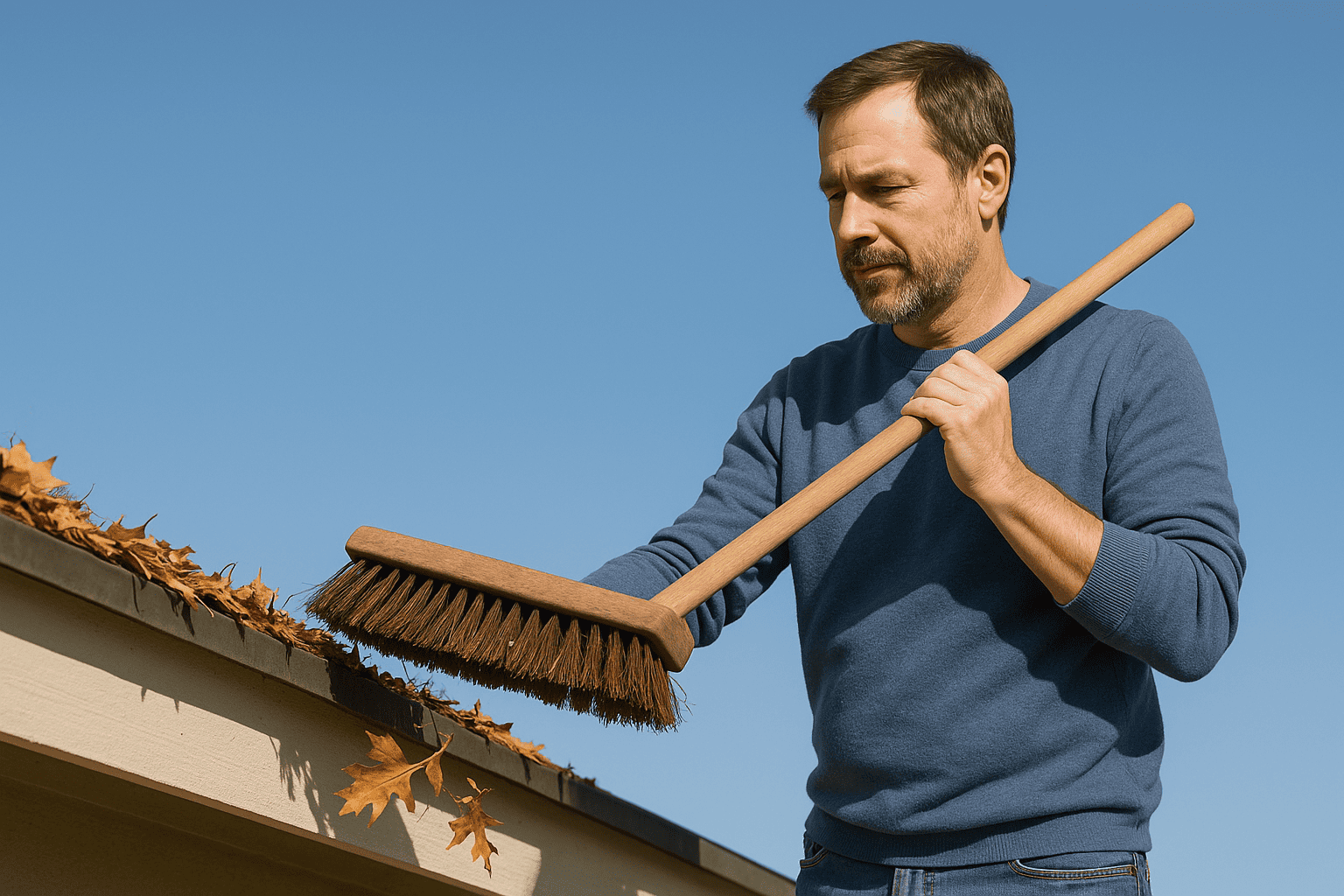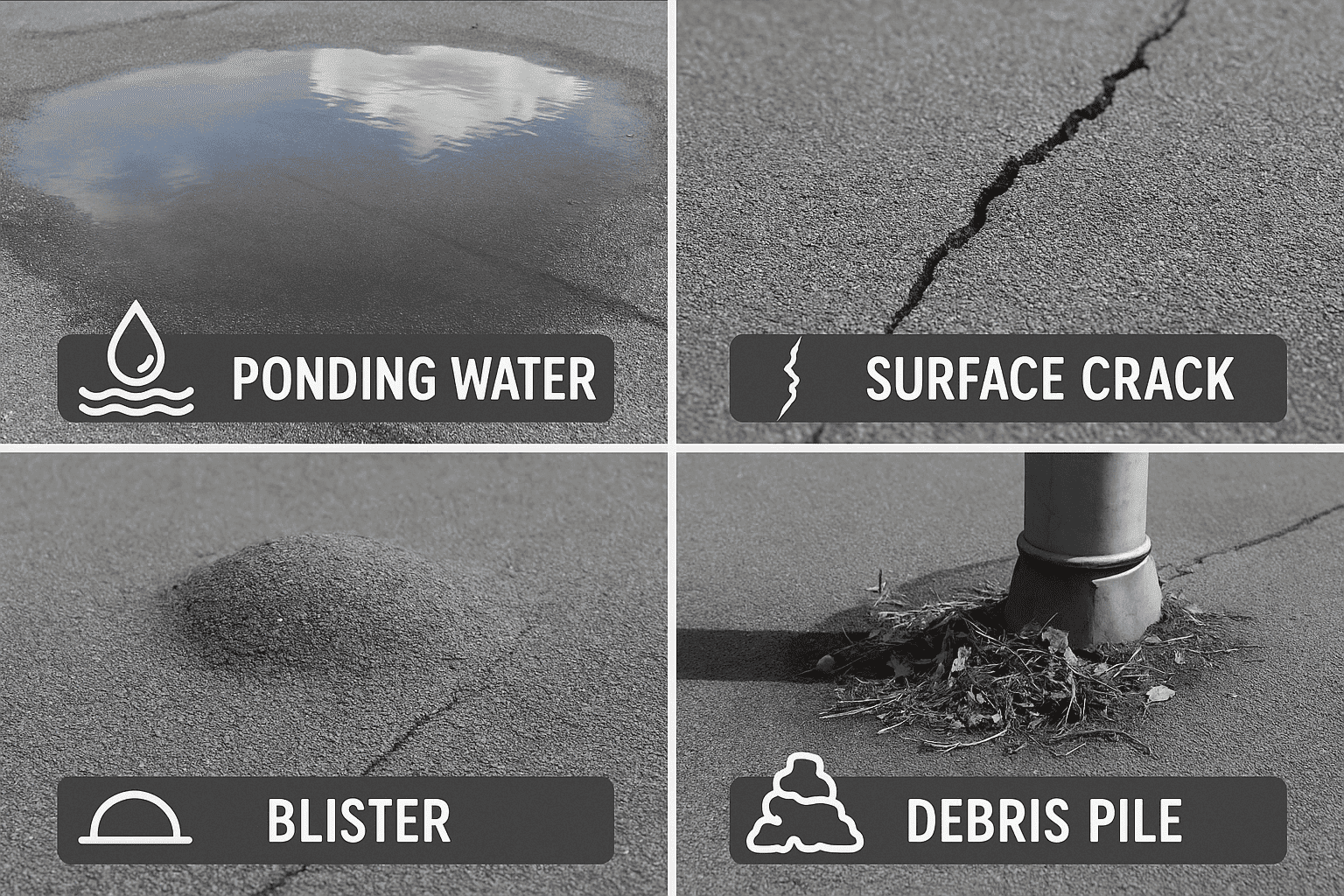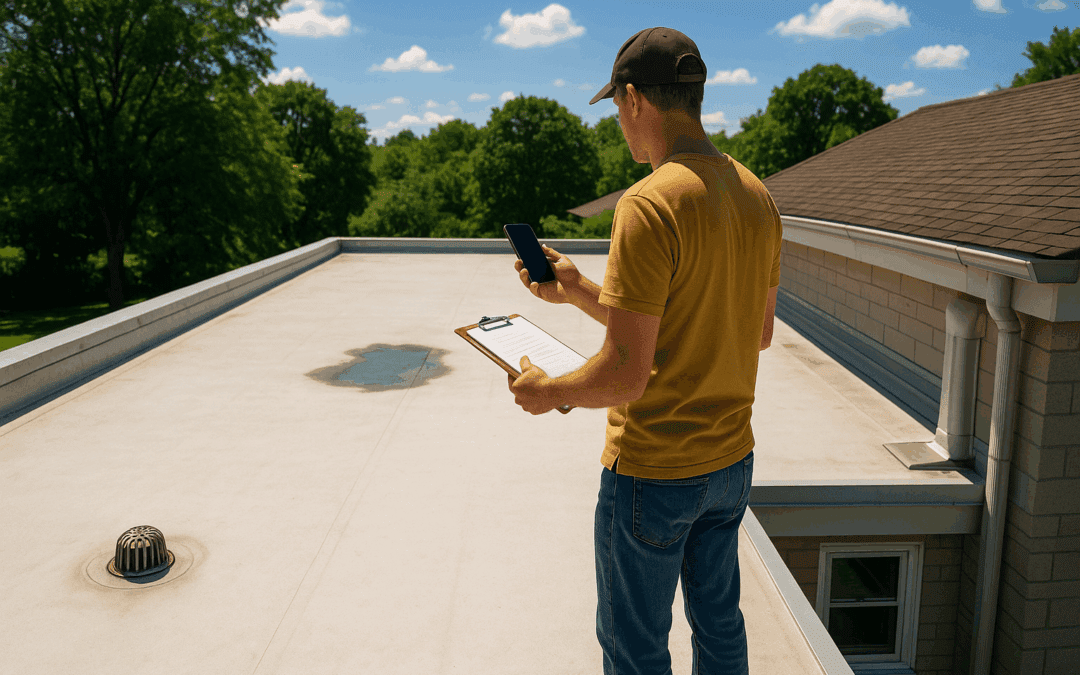Your fast, no-hassle roadmap to a healthy roof
1. Introduction
Mid-summer’s warm, dry weather makes it the perfect time for a quick flat-roof check. A few simple steps now can catch small issues before autumn rains turn them into big headaches. Follow this guide to inspect your roof confidently—even if you’re no handyman—in under an hour.
2. What Is a Flat-Roof Inspection?
A flat-roof inspection is a systematic walk-through—both outside and inside—designed to spot damage, leaks, and wear. You’ll examine the roof surface, drain areas, flashings, seals, and look for moisture inside. The goal isn’t to become a professional roofer but to assess whether your roof needs cleaning, minor patching, or a call for expert help. By knowing what to look for, you’ll save money on flat roof repair cost and avoid nasty surprises when storms hit. Think of it like a health check: catch symptoms early, treat them fast, and your roof will stay strong for years.
3. Common Challenges Homeowners Face with Flat Roofs
Flat roofs are great for patios and easy maintenance—but they have quirks.
3.1. Water Pooling (Ponding)
Flat sections don’t drain as quickly, so rainwater can sit in shallow “puddles,” causing rot and leaks over time.
3.2. Leaks and Moisture
Tiny cracks let water in; even minor damp spots under the ceiling signal potential mold or structural damage.
3.3. Poor Drainage
Clogged or misaligned drains force water to back up, worsening ponding and inviting insects or debris.
3.4. Blistering and Cracking
Heat and UV rays expand roofing material, forming blisters that burst and crack, creating entry points for water.
3.5. Shorter Lifespan
Compared to pitched roofs, flat membranes often wear out faster—regular checks help you replace them on your schedule.
3.6. Higher Maintenance Needs
Flat roofs require more frequent cleaning, sealant renewal, and debris removal to prevent damage.
4. Benefits of Mid-Summer Inspections

A split-scene comparison showing a flat roof exposed to an autumn storm (left) versus a calm summer inspection (right)
Mid-summer offers consistent weather and clear skies—ideal for a thorough look at your flat roof. With no rain forecast, you can safely check for Seasonal Maintenance tasks like clearing debris, inspecting drains, and tightening loose flashings. Spotting ponding or sealant gaps now gives you time to book minor repairs before cooler, wetter autumn days make work messy and costly. Early fixes curtail water damage, mold growth, and structural decay. Plus, mid-summer inspections help you plan outdoor projects—like rooftop gardens or HVAC upgrades—around a healthy roof. By tackling small issues now, you reduce your long-term flat roof repair cost and keep your property safe, comfortable, and leak-free all year.
5. When to Schedule Your Inspection
Aim for late July to early August, when heat has stressed the roof but before fall storms arrive. If you notice water stains after heavy rains or small plants sprouting near drains, book an immediate check. Ideally, inspect within 24–48 hours after a dry spell to see lingering signs of ponding or moisture. Set a calendar reminder each year—mid-summer checks become as effortless as changing your smoke-alarm batteries.
6. Essential Maintenance Tips for Flat Roofs in GTA

Clearing leaves and debris from the flat roof edge helps prevent drainage blockages and ponding.
Living in the GTA means hot summers and sudden downpours. Keep your flat roof in top shape:
- Regular Debris Removal:
Sweep away leaves, twigs, and dirt monthly. Blocked drains lead to ponding. - Inspect Flashings & Seals
Flashings (where roof meets walls or vents) wear out first. Look for cracks or gaps and reseal with roof-grade caulk. - Trim Overhanging Branches
Branches scrape membranes and drop debris. Keep limbs 2–3 feet away. - Check Drainage Points
Clear wires, shingles, or dirt clogging scuppers and downspouts to maintain water flow. - Monitor for Algae or Moss
Dark streaks or green patches signal biological growth. A gentle power- Roof Cleaning will restore the surface. - Seasonal Seal Coating
A reflective roof coating applied every 2–3 years helps UV resistance and prevents cracks.
Following these tips cuts down on costly leaks and extends your roof’s lifespan—just a few hours a season keeps your home dry and worry-free.
7. How to Prepare for Your Flat Roof Inspection
Gather tools and plan ahead to make your mid-summer check swift and safe.
- Check Weather & Schedule
Pick a clear day with temperatures under 30 °C. Wear sturdy, non-slip shoes. - Clear Roof Access
Remove obstacles near ladders. Inform household members and secure pets before climbing. - Gather Equipment
- Ladder with stabilizer
- Flashlight
- Chalk or colored tape
- Camera or smartphone
- Tape measure
- Safety gloves and glasses
- Review Past Reports
If you have previous inspection notes or invoices, flag recurring trouble spots—flashings, drains, or patched areas. - Set Up a Spotter
Have someone on the ground to hold the ladder, pass tools, and call for help if needed. - Create a Notes Template
Jot down categories: Drainage, Membrane, Flashings, Interior Ceiling. Use a simple checklist so you don’t miss steps. - Charge Your Phone
You’ll snap photos to document issues—essential for quoting repairs or sharing with pros when you search for a “roof inspection service near me.”
Once you’re prepped, the inspection flows smoothly—no surprises, no wasted trips up and down.
8. Step-by-Step Flat Roof Inspection Process
Before you climb up, here’s a clear, sequential method to make sure you cover every corner of your roof safely and thoroughly.
8.1. Prepare for the Inspection
Place your ladder securely and use chalk to mark zones on the roof for systematic coverage.
8.2. Look Inside for Signs of Damage
Before stepping outside, check the attic or ceiling for stains, mold, or crusty mineral deposits—early clues of leaks.
8.3. Inspect the Roof Surface
Walk slowly, feeling for soft spots underfoot. Scan the membrane for cracks, punctures, or worn patches. Touch any bubbles; firm is good, spongy means trapped moisture.
8.4. Check Roof Drainage
Examine scuppers and downspouts. Pour a bucket of water near each drain; watch how fast it flows. If water pools for more than 2–3 minutes, clear blockages or notes for repair.
Contextual HRPM Link:
When you find stubborn clogs, a professional Roof Drainage service can prevent ponding damage.
8.5. Examine Flashings and Seals
Inspect metal or rubber flashings around vents, chimneys, and edges. Look for rust, gaps, or wrinkling. Reseal minor splits with roofing sealant.
8.6. Look for Vegetation or Debris
Remove any plant growth or fallen leaves/bricks. Organic matter holds moisture against the membrane, accelerating wear.
8.7. Check Roofing Equipment
If you have HVAC units or solar panels, inspect their bases and mounts. Loose brackets can tear the roof and cause leaks.
8.8. Document Your Findings
Photograph every issue and note its location (e.g. “Northwest corner, 1 m from scupper”). Clear visuals help pros quote repairs faster when you Google “roof inspection service near me.”
8.9. Decide on Next Steps
Minor cracks you can seal yourself. Anything structural or widespread calls for professional evaluation and quote.
9. Typical Problems Found During Inspections

Common flat-roof problems—ponding water, surface cracks, blisters, and debris buildup—spot-checked during a mid-summer inspection.
Even a quick mid-summer check reveals patterns:
- Ponding Water: After a rain, shallow pools linger—which over time soften membrane layers and invite leaks.
- Surface Cracks: Thermal expansion and foot traffic cause fine splits; left unchecked, they widen to allow moisture in.
- Blistering & Bubbling: Trapped air or moisture under the membrane shows up as raised blisters, vulnerable to punctures.
- Flashing Separation: Metal edges peel away, breaking the seal around vents, walls, and skylights.
- Debris Buildup: Leaves, gravel, and trash accumulate at drains, creating unexpected dams.
- Roof Membrane Wear: Thin spots from UV exposure look dull or chalky, signaling it’s time for a reseal.
Catching these issues early slashes repair bills. A small DIY patch kit for minor cracks costs under $50; waiting until winter could mean tear-off and replacement costing thousands.
10. Safety Tips for Non-Experts Performing Roof Inspections
Safety first! Before heading onto your roof, read these quick guidelines to keep you protected from falls, heat stress, and unexpected hazards.
- Use a Spotter: Always have a helper steady your ladder.
- Stay Away from Edges: Keep a 1.5 m buffer from parapets or gutters.
- Wear Protective Gear: Slip-resistant boots and safety glasses are musts.
- Avoid Work in Heat: Inspect mornings or late afternoons to prevent heat exhaustion.
- Know When to Stop: If the roof feels unstable or you’re uneasy, step down and call a pro.
Follow these rules to keep your mid-summer inspection safe and worry-free.
11. When to Call Professional Help

HRPM technician arrives on-site in a branded van, ready for fast, reliable home-maintenance service.
If you find large membrane tears, persistent ponding, or structural sagging, it’s time to call in the experts at HR Property Maintenance (HRPM). Pros have the tools and training to diagnose hidden damage and recommend lasting fixes. For fast, reliable service you can Contact Us any time, 24/7. A quick consult helps you understand repair options—from localized patching to full resealing—so you can budget and schedule work before the next storm rolls in.
12. Post-Inspection Maintenance Tips
Once you’ve checked and patched your roof, keep it in top shape with these simple follow-up actions.
- Schedule Quarterly Quick Checks: A 10-minute walk-through each season catches small changes early.
- Keep Drains Clear Year-Round: Use a gutter scoop or hire a service to avoid blockages.
- Apply Reflective Coatings: A reflective sealant in early fall reduces UV wear and lowers cooling costs.
- Document Every Service: Store inspection photos, invoices, and notes in one folder—handy for future checks or insurance claims.
- Set Calendar Reminders: Automate alerts every four months so roof care stays on your radar.
This simple routine keeps your investment secure and defends against leaks, mold, and expensive repairs.
13. Conclusion
A mid-summer flat-roof inspection is your best defense against leaks and costly fixes. With a clear plan, basic tools, and a safety-first mindset, you’ll spot trouble early. When in doubt, calling a trusted “roof inspection service near me” ensures professional care and peace of mind—rain or shine.
14. Frequently Asked Questions
Let’s wrap up with answers to the most common concerns about flat-roof inspections—fast, clear, and practical.
14.1. How often should I inspect my flat roof?
At minimum twice a year—mid-summer and early spring—plus after major storms.
14.2. How do you inspect a flat roof?
Follow the step-by-step process above: interior check, surface scan, drainage test, and flashing review.
14.3. What to look for in a flat roof?
Watch for ponding, membrane cracks, blistering, flashing separation, and debris buildup.
14.4. How do I know if a leak is serious?
Widespread ceiling stains, sagging, or mold growth require immediate professional attention.
14.5. When to schedule your flat roof inspection?
Choose late July to early August, when dry weather offers the clearest view of roof health.
14.6. How often does a flat roof need to be resealed?
Every 2–5 years, depending on UV exposure and wear—mid-summer inspections help you time it right.
14.7. Where do flat roofs leak most?
At flashings around vents, drains, and edges where water pools or seals degrade.
14.8. What is the most common defect in a flat roof?
Ponding water leading to membrane cracks and seal failure is the top culprit.
14.9. When should a flat roof be replaced?
Once the membrane shows severe wear—multiple blisters, widespread cracks—or exceeds its 10–15-year lifespan.
14.10. What tools do I need for a basic flat roof inspection?
A sturdy ladder, flashlight, camera or phone, tape measure, chalk or tape for marking, and safety gloves/glasses.

